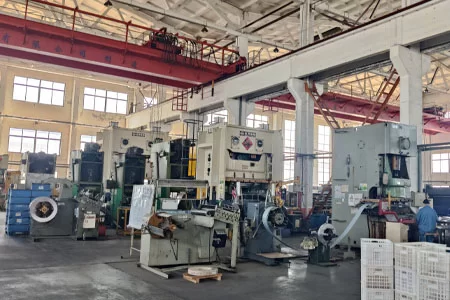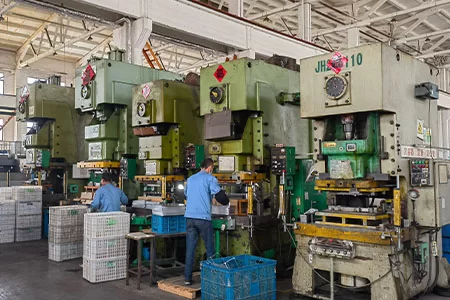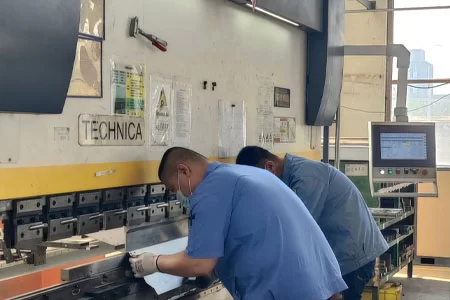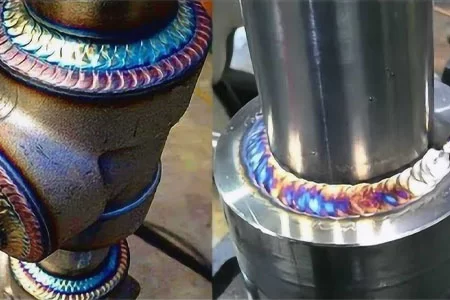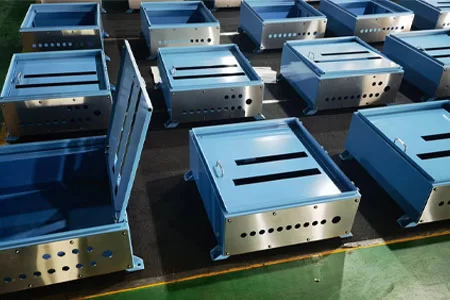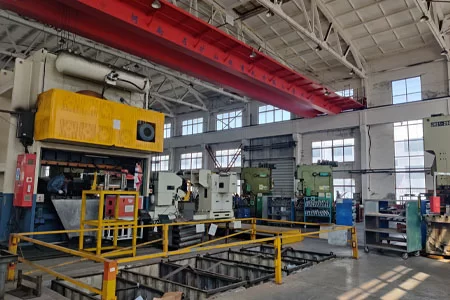This extensive guide explores sheet metal bending in detail, covering definitions, production processes with troubleshooting, material considerations, product applications across various industries, and key factors for selecting a contract manufacturing p

Gain comprehensive insights into sheet metal bending—including production processes, material selection, and practical tips for choosing a reliable manufacturing partner.
Sheet Metal Bending: An Expert Definitive In-Depth Guide to Production, Materials, Applications, and Partner Selection
-
Home>
-
Blog>
-
Technology>
Comprehensive Guide to Sheet Metal Bending
Sheet Metal Bending: A Comprehensive Guide
Sheet metal bending is a cornerstone process in modern metal forming that transforms flat sheets into functional, angular components. In this comprehensive guide, we explore every facet of sheet metal bending—from its definition and production processes (including common issues and solutions) to material considerations, diverse product applications (covering server, trailer, automotive, and building prefabrication products), and the critical factors for selecting a contract manufacturing partner. Whether you are an engineer, production manager, or industry professional, this guide offers the in-depth insights and practical tips needed to optimize quality, efficiency, and cost-effectiveness in your manufacturing operations.
1. Understanding Sheet Metal Bending
Sheet metal bending is a metal forming process in which a flat metal sheet is deformed along a predetermined line to produce a permanent angular change. During this process, the metal is clamped along one edge or over a die, and a bending force—often applied via a punch or pressure mechanism—is introduced to create a precise bend. The final geometry, including the bending angle and radius, is determined by the distance the force is applied and the shape of the bending die.
Modern sheet metal bending has evolved significantly with the integration of computer numerical control (CNC) technology. CNC bending machines provide precise control over critical variables such as the bending force, speed, and feed rate. This precision minimizes variations between parts and ensures a consistent quality across high-volume production runs. The process is versatile enough to work with a range of materials—such as aluminum, stainless steel, brass, and mild steel—each offering unique benefits and challenges.
One of the primary advantages of sheet metal bending is its cost-effectiveness. Unlike more complex forming methods that require expensive dies or molds, bending typically demands minimal tooling. This lower tooling cost makes bending especially attractive for both low-volume custom projects and high-volume production. Additionally, companies like HULK Metal offer dedicated sheet metal bending services. They focus on delivering high-precision components and, in cases where quality issues or shipment discrepancies occur, their after-sales service is solely dedicated to managing returns, exchanges, or replenishments for defective or under-shipped products.
Overall, sheet metal bending plays a vital role in manufacturing by combining functionality with aesthetic appeal. Its efficiency, precision, and versatility make it indispensable in numerous industries.
2. Production-Related Knowledge
Achieving high-quality bent components relies on a deep understanding of the entire production process. This section provides a comprehensive look at production techniques, process flows, common issues, and effective solutions in sheet metal bending.
2.1 Overview of Production Techniques
The journey begins with selecting high-quality metal sheets. Quality control at the raw material stage is crucial—any surface imperfections or inconsistencies can become magnified during bending. Manufacturers perform detailed inspections, including thickness measurements and surface quality assessments, to ensure the sheets meet strict standards.
Once approved, the metal sheet is prepared for bending. Preparation includes cleaning to remove oils, dust, or contaminants, and in some cases, pre-heating the metal to enhance ductility. Pre-heating is particularly beneficial for materials that are prone to cracking under stress, as it helps the metal reach an optimal forming temperature.
2.2 Machine Setup and Clamping Systems
Proper machine setup is essential for achieving precise bends. Modern bending machines are equipped with robust clamping systems designed to hold the metal securely in place. During setup, the sheet is loaded onto the machine and aligned accurately with the bending die. Even a slight misalignment can lead to uneven bends or defects. Skilled operators use precision tools, such as laser alignment devices and micrometers, to verify that the sheet is correctly positioned before initiating the bending operation.
2.3 Integration of CNC and Automation
Advances in CNC technology have revolutionized sheet metal bending. CNC bending machines enable manufacturers to control process parameters with extreme precision. These machines are programmed with the desired bending angle, radius, and force, ensuring repeatable and accurate results. Automated systems continuously monitor parameters like force application, bending speed, and material deformation. Real-time data from integrated sensors allow for immediate adjustments, minimizing errors such as over-bending or under-bending.
Automation significantly reduces human error and is especially valuable in high-volume production environments. Consistency is paramount, and CNC technology ensures that every bend is executed identically, leading to parts that meet rigorous quality standards.
2.4 Detailed Process Flow and Parameter Optimization
Optimization of process parameters is key to achieving high-quality outcomes. Several variables must be precisely managed:
- Bending Angle:
The target angle is pre-programmed, and adjustments are made to account for material springback—a phenomenon where the metal partially returns to its original shape.
- Bending Radius: The curvature of the bend is determined by the shape of the die and the force applied.
- Force and Speed:
The speed of the bending operation must be balanced with the force applied; too much force at high speed can cause cracking, while too little force may not achieve the desired bend.
- Tool Positioning:
The exact position of the punch relative to the die is critical for a uniform bend.
Simulation software is often used to model the bending process before production begins. By simulating stress distribution and predicting springback, engineers can adjust settings to minimize material waste and defects.
2.5 Common Production Challenges
Even with advanced technology, several challenges can arise during sheet metal bending:
- Springback:
After bending, metal often attempts to return to its original shape. This effect is managed by over-bending slightly, a technique that requires precise control.
- Cracking and Fracturing:
Excessive force or improper material selection can lead to cracks in the bent component. Operators must carefully control the bending force and monitor the material's behavior.
- Distortion and Warping:
Misalignment or uneven pressure can cause distortion, resulting in components that do not meet dimensional tolerances.
- Tool Wear:
The high stresses involved in bending can lead to accelerated wear on tooling. Regular maintenance and the use of high-durability materials for tools are essential to ensure long-term performance.
2.6 Solutions to Production Issues
To overcome these challenges, manufacturers employ several strategies:
- Pre-Bend Simulation:
Using simulation software to model the bending process allows for the adjustment of parameters before production, reducing the risk of springback and distortion.
- Real-Time Monitoring:
Integrated sensors and feedback systems allow for continuous adjustments, ensuring that the bending process remains within acceptable limits.
- Preventive Maintenance:
Routine cleaning, lubrication, and calibration of machines and tools prevent issues related to wear and tear.
- Skilled Operator Intervention:
Even with automation, experienced operators are essential for managing unexpected issues and fine-tuning the process.
2.7 Maintaining a Controlled Production Environment
Environmental factors play a significant role in the bending process. Ambient temperature, humidity, and even vibration levels in the production area can impact the quality of the final product. Manufacturers maintain strict environmental controls and schedule regular maintenance to ensure that machines operate at peak efficiency. A stable production environment minimizes variations and supports consistent quality.
2.8 Quality Control Measures
Quality control is integrated at every stage of production. Beginning with raw material inspection and continuing through to the final product, each component undergoes rigorous testing. Precision instruments such as laser micrometers and coordinate measuring machines (CMM) verify dimensions, while non-destructive testing methods (e.g., computerized tomography scans) inspect internal structures without damaging the component. These measures ensure that any defects are detected early and corrected promptly.
2.9 Production Equipment Capabilities
Modern bending machines are engineered for both precision and high throughput. Although specific equipment brands are not disclosed, these machines are known for their robust clamping systems, high-torque motors, and advanced CNC controls. Their production capabilities enable them to handle both custom low-volume orders and large-scale production runs without compromising quality.
2.10 HULK Metal's Bending Service Capabilities
Companies like HULK Metal have perfected the art of sheet metal bending. Their facilities are equipped with state-of-the-art machines that combine advanced CNC technology with high production capacity. HULK Metal focuses solely on delivering high-precision bent components that meet stringent tolerances. Additionally, if any quality issues or shipment discrepancies occur, their after-sales service is dedicated exclusively to managing returns, exchanges, or replenishments for defective or under-shipped products.
2.11 Summary of Production-Related Knowledge
In summary, the production of sheet metal bending components is a complex process that combines high-quality raw materials, precise machine setups, advanced CNC automation, and rigorous quality control. By addressing challenges such as springback, cracking, and distortion through simulation, real-time monitoring, preventive maintenance, and skilled operator intervention, manufacturers can achieve superior quality and operational efficiency.
3. Sheet Metal Bending Process Flow
A detailed understanding of the process flow is essential to mastering sheet metal bending. The process can be broken down into several key stages, each of which plays a critical role in the quality and consistency of the final product.
Stage 1: Raw Material Preparation
- Material Inspection:
The process begins with the careful selection and inspection of the metal sheet. Quality control tests confirm that the sheet meets the required specifications in terms of thickness, surface integrity, and composition.
- Cleaning:
The metal is thoroughly cleaned to remove any contaminants such as oils, dust, or debris that could interfere with the bending process.
- Pre-Treatment:
For some materials, pre-heating may be necessary to improve ductility. Pre-heating helps the metal reach an optimal temperature, reducing the likelihood of cracking during bending.
Stage 2: Clamping and Positioning
- Loading the Machine:
Once prepared, the metal sheet is loaded onto the bending machine.
- Securing the Sheet:
Advanced clamping systems secure the sheet firmly, ensuring that it remains stationary throughout the process.
- Precise Alignment:
The sheet is carefully aligned with the bending die. Accurate alignment is critical, as any misalignment can lead to uneven bending or dimensional inaccuracies.
- Verification:
Operators use precision tools to verify that the sheet is correctly positioned before proceeding.
Stage 3: Initiation of Bending
- Initial Contact:
With the sheet securely clamped, the bending tool (or punch) makes initial, light contact with the metal. This pre-bend stage allows the sheet to begin conforming to the shape of the die.
- Gradual Force Application:
The bending force is introduced gradually to minimize the risk of material damage. Sensors start to record data such as force, displacement, and sheet deformation.
Stage 4: Progressive Bending
- Incremental Deformation:
The bending process enters a phase of progressive deformation, where the machine increases the applied force incrementally. This step-by-step approach helps control the bending angle and ensures that the metal adapts uniformly to the die's shape.
- Compensation for Springback:
As the metal is bent, it tends to spring back slightly. The CNC system compensates for this by over-bending the component by a calculated margin.
- Real-Time Adjustments:
Integrated sensors and real-time monitoring allow the machine to adjust parameters on the fly, ensuring that the final bend meets the target specifications.
Stage 5: Finishing Passes
- Surface Smoothing:
After the main bending operation, finishing passes are performed using lower force and slower feed rates. These passes smooth out any minor irregularities and refine the component's final shape.
- Dimensional Refinement:
Fine adjustments ensure that the component's dimensions—such as bend angles and radii—are within the prescribed tolerances.
- Operator Inspection:
During and after finishing passes, operators perform visual and measurement inspections to ensure quality.
Stage 6: Cooling and Stabilization
- Controlled Cooling:
Once bending is complete, the component is allowed to cool gradually. This cooling phase can be passive or assisted by cooling systems to control the rate of temperature decrease.
- Stress Relief:
Controlled cooling helps stabilize the internal structure of the metal, reducing residual stresses and ensuring that the component retains its final shape.
- Final Settling:
The component is allowed to reach ambient temperature, ensuring that no further dimensional changes occur.
Stage 7: Final Inspection and Quality Control
- Non-Destructive Testing:
The final component undergoes rigorous quality control using non-destructive testing methods such as laser scanning and computerized tomography (CT) to verify internal and external dimensions.
- Measurement Verification:
Precision instruments confirm that the component meets all design specifications.
- Defect Management:
Any components that do not pass the inspection are set aside for re-processing or rejection, ensuring that only top-quality products proceed to shipment.
Process Flow Summary
The sheet metal bending process flow—from raw material preparation and precise clamping to progressive bending, finishing, cooling, and final inspection—is a carefully orchestrated sequence designed to produce high-quality components. Advanced CNC controls, real-time adjustments, and integrated quality control measures ensure that each component is consistent, accurate, and reliable.
4. Material Considerations in Sheet Metal Bending
Selecting the right material is critical for successful sheet metal bending. The properties of the metal—such as ductility, strength, and thickness—directly affect the bending process and the quality of the final component. In this section, we delve into the characteristics, advantages, and challenges associated with common materials used in sheet metal bending.
4.1 Importance of Material Selection
Material selection influences the ease of forming, the risk of defects, and the overall performance of the bent component. A thorough understanding of material properties helps manufacturers optimize process parameters and achieve consistent results.
4.2 Aluminum
Aluminum is a popular choice for sheet metal bending due to its:
- Lightweight Nature:
Aluminum's low density makes it ideal for applications where weight reduction is critical.
- High Ductility:
Its excellent formability allows for intricate bends and complex shapes.
- Corrosion Resistance:
Aluminum naturally forms a protective oxide layer, enhancing durability.
- Challenges:
Due to its relative softness, aluminum can be prone to over-thinning if excessive force is applied. Precise control over bending parameters is necessary to maintain structural integrity.
4.3 Stainless Steel
Stainless steel is widely used when high strength and durability are required:
- Strength and Toughness:
Its superior strength makes it suitable for structural applications.
- Aesthetic Appeal:
Stainless steel offers an attractive finish that is ideal for visible components.
- Corrosion Resistance:
It resists oxidation and corrosion, even in harsh environments.
- Challenges:
The higher strength and lower ductility compared to aluminum require higher forces during bending. Advanced machinery and tight control over process parameters are needed to avoid cracking or uneven bending.
4.4 Brass and Copper
Brass and copper are chosen for their unique properties in specialized applications:
- Excellent Conductivity:
Both metals offer superior electrical and thermal conductivity, making them suitable for electronic and decorative applications.
- Malleability:
Their high malleability allows for detailed bends and intricate designs.
- Aesthetic Qualities:
Brass and copper provide a warm, distinctive appearance, often used in decorative elements.
- Challenges:
These metals are prone to work-hardening, meaning they become less ductile with repeated bending. This requires the use of specialized lubricants and careful control of bending speeds and forces.
4.5 Mild Steel
Mild steel is favored for its balance of performance and cost:
- Cost-Effectiveness:
It is relatively inexpensive while offering good strength.
- Formability:
Mild steel can be bent with moderate force, making it a versatile choice for many applications.
- Widespread Use:
It is commonly used in industrial and construction applications.
- Challenges:
Mild steel is prone to corrosion if not properly treated. Post-bending surface treatments such as powder coating or painting are often necessary to enhance its durability.
4.6 Surface Treatments and Finishing Processes
After bending, surface treatments can significantly improve both the appearance and functionality of the component:
- Polishing:
Enhances the natural shine and smoothness of the metal.
- Anodizing:
Particularly effective for aluminum, anodizing increases corrosion resistance and offers decorative color options.
- Powder Coating:
Provides a robust, uniform protective layer that improves wear resistance and aesthetic appeal.
4.7 Temperature Control and Lubrication
Controlling the temperature during the bending process is critical:
- Cooling Systems:
Maintain optimal temperatures to prevent overheating, which can alter material properties.
- Lubricants:
The correct lubricant reduces friction between the forming tool and the metal, ensuring smooth bending and reducing wear on tools.
4.8 Quality and Consistency of Raw Materials
Using high-quality raw materials is a prerequisite for successful bending:
- Inspection and Testing:
Rigorous quality control processes ensure that only uniform, defect-free materials are used.
- Uniformity:
Consistent material properties are critical for predictable bending behavior and reliable outcomes.
4.9 Customization of Material Properties
Manufacturers may tailor materials to optimize bending performance:
- Alloy Adjustments:
Modifying alloy compositions can enhance ductility or strength as needed.
- Pre-Treatment:
Processes such as pre-heating or chemical treatments can improve formability and reduce the risk of defects.
4.10 Material Considerations Summary
Successful sheet metal bending hinges on the careful selection and management of materials. By understanding the unique properties and challenges associated with aluminum, stainless steel, brass, copper, and mild steel—and by integrating effective surface treatments, temperature control, and lubrication—manufacturers can consistently produce high-quality, durable components.
5. Production Products and Applications
Sheet metal bending is used to manufacture components across a wide range of industries. In this section, we detail product applications by category and list at least five items for each, focusing on server-related, trailer-related, automotive-related, and building prefabrication-related products.
5.1 Overview of Product Applications
Sheet metal bending enables the transformation of flat sheets into complex shapes, which is essential for creating both functional and aesthetically appealing components. This versatility makes it a preferred process in various industries.
5.2 Server-Related Products
Server systems and data centers rely on precision-engineered metal components for both functionality and design. Common sheet metal bending applications in this sector include:
5.2.1 Racks
- Server Racks: Structural frameworks that securely house servers.
- Network Racks: Specialized racks designed to accommodate network equipment.
- Blade Server Racks: Racks engineered for high-density blade server installations.
- Rack Enclosures: Enclosed frameworks that protect sensitive equipment.
- Modular Racks: Configurable racks that can be adapted to different sizes and specifications.
5.2.2 Cabinets
- Server Cabinets: Secure enclosures that house server equipment.
- Cooling Cabinets: Cabinets designed to optimize airflow and cooling.
- Security Cabinets: Enclosures with enhanced security features for sensitive data.
- Cable Management Cabinets: Cabinets with integrated systems to organize cables.
- Utility Cabinets: Multi-functional cabinets used for ancillary server components.
5.2.3 Brackets
- Mounting Brackets: Support structures for securing servers within racks.
- Accessory Brackets: Brackets designed for additional server peripherals.
- Cooling Brackets: Brackets that assist in mounting cooling systems.
- Cable Brackets: Small brackets that help route and secure cables.
- Adjustment Brackets: Brackets that allow for fine-tuning the positioning of components.
5.2.4 Trays
- Server Trays: Flat platforms for mounting servers or related equipment.
- Cable Trays: Trays designed to support and organize cables.
- Cooling Trays: Trays that facilitate air circulation within server enclosures.
- Maintenance Trays: Removable trays for easy servicing.
- Utility Trays: Versatile trays for multiple uses in data centers.
5.2.5 Cable Managements and Blank Panels
- Cable Management Systems: Integrated solutions to route and secure cables.
- Cable Organizers: Components that bundle and protect cable assemblies.
- Blank Panels: Unfinished panels that can be customized for specific server enclosures.
- Ventilation Panels: Panels with designed openings to enhance cooling.
- Utility Blank Panels: Standard panels used as bases for custom modifications.
5.3 Trailer-Related Products
Trailers require robust and precisely engineered components to ensure safety and durability. Key sheet metal bending applications in trailer manufacturing include:
5.3.1 Trailer Frames and Chassis Components
- Frame Rails: Strong, bent components forming the primary structure of a trailer.
- Crossmembers: Reinforcing members that add structural integrity.
- Side Panels: Curved panels that form the sides of the trailer.
- Underbody Shields: Protective panels for the undercarriage.
- Chassis Brackets: Support elements that secure the frame to the axles.
5.3.2 Trailer Cab Enclosures
- Cab Panels: Bent components forming the cab exterior.
- Door Frames: Structural frames for trailer doors.
- Roof Panels: Curved panels used for trailer roofs.
- Window Frames: Precision-bent frames for integrating windows.
- Ventilation Grilles: Bending-produced grilles that facilitate airflow.
5.3.3 Reinforcement Structures
- Support Braces: Cross-bracing elements that enhance structural rigidity.
- Corner Reinforcements: Bent components that strengthen trailer corners.
- Longitudinal Reinforcements: Elements that run the length of the trailer for added stability.
- Lateral Supports: Side supports to prevent twisting and bending under load.
- Impact Absorbers: Components designed to absorb shock during transport.
5.3.4 Accessory Components
- Mounting Brackets: Supports for lights, hitches, and other accessories.
- Tool Racks: Built-in racks for storing equipment on the trailer.
- Tie-Down Bars: Reinforced bars for securing cargo.
- Ladder Frames: Structures for mounting ladders on trailers.
- Storage Compartments: Custom-bent panels that form storage areas.
5.3.5 Safety and Aesthetic Elements
- Side Moldings: Curved trim components that add a finished look.
- Decorative Fascias: Aesthetic elements integrated into the trailer design.
- Reflective Panels: Panels designed to enhance visibility.
- Guard Rails: Safety features that protect the trailer's edges.
- Trim Pieces: Additional elements that provide both functional and decorative benefits.
5.4 Automotive-Related Products
Sheet metal bending is integral to automotive manufacturing, where precision and strength are paramount. Applications in this sector include:
5.4.1 Body Panels and Structural Components
- Hoods: Curved metal panels forming the front cover of the engine compartment.
- Doors: Precisely bent panels that form vehicle doors.
- Fenders: Panels designed to protect the wheel wells and enhance aerodynamics.
- Roof Panels: Curved roof elements that contribute to the vehicle's overall structure.
- Trunk Lids: Bending-produced components that form the rear cover of a vehicle.
5.4.2 Chassis and Frame Components
- Subframes: Structural assemblies that support the engine and suspension.
- Crossmembers: Reinforcing elements that improve chassis rigidity.
- Side Rails: Longitudinal components that form the backbone of the vehicle frame.
- Bumper Reinforcements: Internal supports that enhance bumper strength.
- Roll Cages: Precision-bent structures for added safety in performance vehicles.
5.4.3 Exhaust and Engine Components
- Exhaust Manifolds: Bent metal components that direct exhaust gases.
- Heat Shields: Protective panels to guard sensitive components from heat.
- Engine Covers: Curved panels that encase the engine.
- Catalytic Converter Housings: Structures that support emission control systems.
- Air Intake Ducts: Precisely formed ducts that optimize airflow into the engine.
5.4.4 Interior Components
- Dashboard Frames: Support structures for vehicle dashboards.
- Door Sills: Reinforced panels that form the bottom part of vehicle doors.
- Center Consoles: Bending-formed components for organizing interior controls.
- Seat Frames: Structural elements that provide a base for seating.
- Armrest Supports: Curved supports integrated into the interior design.
5.4.5 Safety and Aesthetic Trim
- Grille Frames: Structural supports for front grilles.
- Window Frames: Precision-bent components for secure window installations.
- Side Skirts: Decorative and functional panels along the vehicle's lower sides.
- Mirror Housings: Curved panels that integrate with side mirrors.
- Roof Rails: Bending-formed rails for added functionality and style.
5.5 Building Prefabrication-Related Products
In the construction industry, sheet metal bending is used to create components that are both structural and decorative. Common applications include:
5.5.1 Structural Elements
- Wall Panels: Bent metal panels used for exterior and interior walls.
- Roofing Sheets: Curved sheets that form durable, weather-resistant roofs.
- Flooring Supports: Reinforced panels that form the basis of raised floors.
- Beams and Girders: Bent elements that provide critical structural support.
- Column Covers: Decorative covers that enhance the appearance of structural columns.
5.5.2 Decorative Facades
- Curtain Walls: Large, curved panels used in modern building exteriors.
- Sunshades: Bent metal fins that provide shading and reduce solar gain.
- Cladding Systems: Panels that add a distinctive look while protecting the structure.
- Accent Elements: Custom-bent trim and moldings for aesthetic enhancement.
- Canopies: Overhanging structures created using bending processes for both form and function.
5.5.3 Utility and Accessory Components
- Ventilation Grilles: Precision-bent panels that ensure adequate airflow.
- Cable Trays: Bending-formed trays that support wiring and cable systems.
- Staircase Components: Curved panels used in the construction of modern staircases.
- Handrail Supports: Structural elements that secure safety railings.
- Utility Boxes: Custom-bent enclosures for electrical and mechanical systems.
5.5.4 Integration Elements
- Door Frames: Precisely bent frames that ensure proper door alignment.
- Window Sills: Reinforced sills that provide both support and aesthetics.
- Partition Panels: Dividing elements for interior space planning.
- Eaves and Fascias: Decorative and protective elements on building exteriors.
- Ridge Vent Components: Specialized panels that enhance roof ventilation.
5.5.5 Energy Efficiency Components
- Solar Panel Frames: Bent metal structures designed to support photovoltaic modules.
- Insulation Supports: Components that maintain proper spacing for insulation materials.
- Thermal Breaks: Engineered panels that reduce thermal bridging.
- Facade Insulation Systems: Bending-formed components that integrate with external insulation.
- Reflective Barriers: Panels designed to reflect heat and improve energy efficiency.
5.6 Product Applications Summary
Sheet metal bending enables the production of a diverse range of components tailored to the needs of servers, trailers, automobiles, and building prefabrication. Its versatility and precision allow manufacturers to produce both functional and decorative parts, ensuring that every product meets high standards for quality, performance, and aesthetics.
6. Factors for Selecting a Sheet Metal Bending Contract Manufacturing Partner
Choosing the right contract manufacturing partner for sheet metal bending is critical to achieving consistent quality, operational efficiency, and long-term success. This section outlines the essential factors to consider when evaluating potential partners.
6.1 Importance of Partner Selection
A reliable partner impacts every stage of production—from raw material sourcing to final delivery. The right partner can enhance quality control, reduce production costs, and ensure timely deliveries, thereby contributing to overall business success.
6.2 Production Capacity and Equipment Capabilities
- Advanced Machinery:
The partner should operate state-of-the-art bending machines equipped with advanced CNC controls. These machines must deliver precise, repeatable bends and be capable of handling both custom low-volume orders and large-scale production.
- High Throughput:
Look for facilities with high production capacity, ensuring that they can meet tight deadlines and adapt to varying order volumes.
- Focus on Capabilities:
Emphasis should be on the machines' production performance rather than specific brand names, as the quality of output is paramount.
6.3 Technical Expertise and Process Management
- Skilled Workforce:
The ideal partner will have experienced engineers and machine operators who understand the intricacies of sheet metal bending. Their expertise is critical in setting up the machines, optimizing process parameters, and troubleshooting issues.
- Process Optimization:
Look for evidence that the partner uses simulation software and real-time monitoring systems to optimize bending parameters and mitigate challenges such as springback or distortion.
- Problem-Solving Ability:
The partner should be adept at quickly resolving production issues to minimize downtime and maintain consistent quality.
6.4 Quality Control and Inspection Procedures
- Rigorous Quality Checks:
A robust quality control system is non-negotiable. The partner must employ in-process inspections, final product testing, and non-destructive evaluation methods (e.g., laser scanning, CT imaging) to ensure that every component meets design specifications.
- Certifications:
International quality certifications (such as ISO 9001) provide assurance of the partner's commitment to maintaining high standards.
- Continuous Improvement:
The partner should regularly review production data and implement process improvements to enhance quality and efficiency.
6.5 Material Handling and Integrated Finishing Services
- Expertise with Multiple Materials:
The partner should have extensive experience working with a variety of metals—such as aluminum, stainless steel, brass, copper, and mild steel—and be able to tailor the process to each material's properties.
- In-House Finishing:
Integrated finishing services (polishing, anodizing, powder coating) are highly desirable as they streamline production and ensure a consistent, high-quality finish.
- Material Quality Assurance:
A commitment to rigorous raw material inspections ensures that only the highest quality materials are used in production.
6.6 Turnaround Time and Production Flexibility
- Rapid Production:
Fast turnaround times are essential in today's competitive market. The partner should be capable of adapting quickly to design changes or custom orders.
- Lean Processes:
Efficient workflow management and lean manufacturing practices are indicators of a partner's ability to meet deadlines without compromising quality.
- Scalability:
The partner must be able to scale production according to order volume, ensuring that quality remains consistent regardless of batch size.
6.7 Cost Efficiency and Transparent Pricing
- Clear Pricing Structure:
Transparent pricing with no hidden fees is a critical factor. The cost should accurately reflect the partner's production capabilities, quality control measures, and integrated finishing services.
- Value for Money:
Evaluate the overall value offered by the partner, including potential savings from reduced waste and improved efficiency.
- After-Sales Support:
Companies like HULK Metal provide clear pricing along with dedicated after-sales service focused on managing returns, exchanges, or replenishments for quality issues or shipment discrepancies.
6.8 Communication and Customer Service
- Regular Updates:
The partner should maintain open communication channels, providing timely production updates and clear timelines.
- Responsive Support:
A proactive customer service team that quickly addresses queries and resolves issues is essential for a smooth, collaborative partnership.
- Collaboration:
The ability to work closely with your team and provide tailored solutions enhances the overall production experience.
6.9 Certifications, Compliance, and Sustainability
- Regulatory Compliance:
Ensure that the partner adheres to all relevant industry standards and environmental regulations.
- Sustainability Practices:
Commitment to sustainable manufacturing practices, such as reducing waste and energy consumption, can provide long-term benefits and align with corporate social responsibility goals.
- Industry Certifications:
Certifications serve as an indicator of the partner's dedication to quality, safety, and continuous improvement.
6.10 Long-Term Partnership and Innovation
- Future Collaboration:
Consider the potential for a long-term relationship. A partner that invests in research and development and embraces digital manufacturing tools is better positioned to offer innovative solutions.
- Continuous Improvement:
Long-term partnerships foster ongoing process optimization, resulting in higher quality products and improved operational efficiencies.
- Trust and Reliability:
A partner that demonstrates reliability and a commitment to mutual growth is invaluable in a competitive manufacturing landscape.
6.11 Summary of Partner Selection Factors
Choosing the right sheet metal bending contract manufacturing partner involves a careful evaluation of production capacity, technical expertise, quality control, material handling, turnaround time, cost efficiency, communication, certifications, and long-term innovation potential. By thoroughly assessing these factors, businesses can select a partner that not only meets immediate production needs but also supports long-term growth and continuous improvement in metal forming operations.
This comprehensive guide on sheet metal bending covers the essential definitions, production processes—including step-by-step flows, common issues, and solutions—detailed material considerations, extensive product applications (with over five examples per category for server, trailer, automotive, and building prefabrication sectors), and the critical factors for selecting a reliable contract manufacturing partner. By leveraging advanced CNC technology, rigorous quality control, and the expertise of skilled professionals—and with service capabilities provided by companies like HULK Metal (which also offer after-sales support exclusively for handling returns, exchanges, or replenishments due to quality issues or shipment discrepancies)—manufacturers can achieve superior quality and operational efficiency in today's competitive market.
Article Navigation
Article Navigation
Industries
Foundries
-

November.21, 2024
HULK Metal Stamping Factory Show
READ MORE
-

October.18, 2024
HULK Metal Fabrication
READ MORE
-

October.24, 2024
Comprehensive Guide to Sheet Metal Blanking
READ MORE
-

September.30, 2024
Comprehensive Understanding of Sheet Metal Welding
READ MORE
-

September.27, 2024
8 Types of Sheet Metal Assembly Technology and Their Processes and Applications
READ MORE
-

September.19, 2024
Introduction to Metal Stamping Processes
READ MORE



